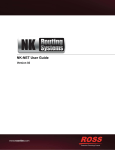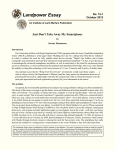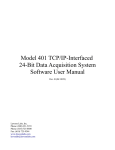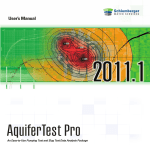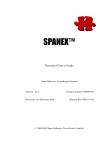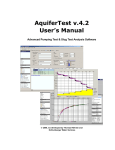Download Extended Abstract - AMS supported meetings
Transcript
5.4 NEXRAD OPEN RADAR DATA ACQUISITION (ORDA) SIGNAL PROCESSING & SIGNAL PATH Nita K. Patel* and Robert W. Macemon RS Information Systems, Inc., Norman, Oklahoma 1. ABSTRACT The Open Radar Data Acquisition (ORDA) subsystem replaces the current WSR-88D Radar Data Acquisition subsystem with improved receiver and signal processing hardware and with improved user interface, signal processing and diagnostics software. This paper will discuss the input data from the digital receiver, the ORDA signal processing, and the data output from the ORDA hardware. Specifications of the ORDA digital receiver will be presented. The paper outlines the critical radar signal processing flow and provides analysis of new spectrum width computations and clutter filtering schemes used in the ORDA system. Where appropriate, ORDA performance enhancements, data quality improvements and reliability and maintenance improvements will be highlighted. 2. INTRODUCTION Earlier papers defined key RDA functionality (Zahrai et al, 2002) that the ORDA program will replace and signal processing requirements (Torres, 2002) that the ORDA program will fulfill. The NEXRAD Program Management Committee (Cate, 2003) accepted the commercial SIGMET RVP8/RCP8 system for the ORDA program and modified the contract in May 2002. This paper presents a technical description and status of the current ORDA design. The ORDA system provides enhanced performance by taking advantage of new and emerging technologies and by incorporating improved signal processing techniques. Key differences between the ORDA architecture and legacy RDA architecture are highlighted below: * Corresponding author address: Nita K. Patel, RS Information Systems, Inc., 2227 W. Lindsey Ave., Suite 1500, Norman, OK 73069; e-mail: [email protected] ORDA vs. LEGACY Commercial OffThe-Shelf (COTS) hardware vs. Proprietary hardware Software signal processing vs. Hardware signal processing Digital Intermediate Frequency (IF) vs. Analog IF & digital video Graphical User Interface vs. ASCII text-based screens Integrated maintenance application vs. Separate maintenance application Accurate system time vs. No system time Local base data display vs. No base data display The ORDA design is replacing proprietary hardware, e.g., the NEXRAD Hardwired Signal Processor (HSP) and Programmable Signal Processor (PSP), with open-platform commercial hardware, e.g., a commercial PC. Analog receiver components are replaced with a proprietary COTS IF digitizer and, where necessary, suitable commercial analog components. The ORDA hardware design meets all WSR-88D system requirements and incorporates several enhancements proposed for the legacy design. This architecture allows for easy integration and upgrade of the system as hardware performance continues to increase. In addition to open hardware, ORDA development is founded on open software principles. The ORDA Operating System (OS) is Linux and the majority of the radar signal processing software is commercial software written by SIGMET; certain algorithms are company proprietary but a majority of the source is open code and available to RVP8 system developers. SIGMET’s modular software structure provides the ability to modify and/or replace existing SIGMET algorithms with new science algorithms. The RSIS developed user interface, system control, and Radar Product Generator (RPG) interface software consists of functionally modular processes running on a shared memory and event notification infrastructure. 3. HARDWARE System maintainability and availability will be significantly improved with the ORDA design due to the decrease in Line Replaceable Units (LRUs). The ORDA architecture extensively integrates COTS equipment to provide ease of expansion. ORDA architecture includes an IF digital receiver, an accurate GPS Network Time Server (NTS), remote system access, standardized network infrastructure for connections to the RPG and easily upgradeable, standard Pentium processors for signal processing. 3.1 IF Digitizer The ORDA architecture has drastically reduced the number of components in the Radio Frequency (RF) & IF signal path by replacing approximately twenty analog components with an IF digitizer (IFD) and a digital receiver Circuit Card Assembly (CCA). Together, these components create a digital receiver that simplifies system calibration, results in more consistent signal quality and allows flexible control over IF processing. Before digitization, the IF signal and transmit burst pulse sample pass through external anti-alias filters with approximately 2dB loss and passband width of nominally 14 MHz. The transmit pulse burst sample provides necessary data about the transmit pulse frequency, phase and power. A 14-bit Analog to Digital (A/D) converter in the IFD then captures and digitizes the IF energy and the transmit pulse burst sample. Input saturation for both the IF and burst sample is +6 dBm. The RVP8 uses a statistical linearization algorithm to derive correct power levels from targets as much as 6dB above saturation; thereby providing greater than 95 dB of dynamic range. The digitized IF and burst sample data are multiplexed and transmitted via fiber to the digital receiver CCA in the RVP8 processor. 3.2 Receiver Circuit Card Assembly (CCA) The digital receiver CCA converts the digitized IF input to “I” and “Q” values. The Receiver CCA executes the following computations on the IF samples: • Band pass filtering using configurable digital FIR filter matched to pulse width • (I, Q) computation • Burst pulse measurements • Interference rejection. Configurable matched filtering is a significant improvement over the fixed legacy hardware matched filter. The digital matched filter is more exact than the legacy system filter. The legacy filter was designed in hardware and setup specifically for short pulse widths (1.57 µs). In the ORDA architecture, appropriate matched filters for both short pulse and long pulse (4.57 µs) can be configured and applied to the selected pulse width. After matched filtering, the CCA computes the (I, Q) data and computes the burst pulse sample magnitude, which can be used to compensate for transmitter power variations, and phase, which can be used as a reference for velocity and spectrum width estimates. Availability of burst pulse phase information is a significant improvement over the legacy design and this information will be especially important for planned enhancements such as phase coding. Once (I, Q) data is available, the receiver CCA applies a selectable software interference suppression algorithm to the data stream. The software filter replaces the hardware Interference Suppression Unit (ISU) in legacy systems. The software technique relies on the fact that the interference statistics are noticeably different from weather statistics. The SIGMET RVP8 user’s manual provides interference suppression algorithm details (SIGMET, 2003). 3.3 Processors ORDA architecture consists of two system computers, designated RDA Control Processor and RDA Signal Processor, with the same chassis, I/O card and motherboard with dual Pentium processors. Each computer chassis also contains a read/write CD drive, dual 10/100/1000 base-T Ethernet ports, 512 MB RAM, 6 PCI slots and 20 GB hard drives. The RDA Control Processor hosts both SIGMET RCP8 software and RSIS RDA Status and Control Program (RDASC) software. This system is responsible for the control of the RDA equipment. RSIS developed software also provides the Graphical User Interface (GUI) for RDA system operation and control. The RCP8 software provides antenna/pedestal control, system status monitoring, transmitter control, and setup and control of RVP8 signal processing algorithms. The RDA Control Processor communicates with the RDA Signal Processor over a dedicated Gigabit Ethernet port. The RDA Signal Processor executes all required signal processing on the (I, Q) data received from the digital receiver CCA over the PCI bus. The RDA Signal Processor performs clutter filtering, power sum computations, pulsepair sum computations, strong point clutter censoring, batch mode processing, signal thresholding, and range unfolding to produce base moments for transmission to the RPG. 3.4 DAU/DCU Interfaces The RDA Control Processor interfaces to the legacy Data Acquisition Unit (DAU) and Digital Control Units (DCU) to perform antenna/pedestal, receiver, transmitter and tower/utilities control and monitoring. The RDA Control Processor communicates to the DAU and DCU over two of its nine serial RS-232 ports operating asynchronously full duplex at 19,200 bits per second. The RDA Control Processor to DAU interface provides the means of transmitting status and Built In Test (BIT) information from the DAU and of sending commands to the DAU. The RDA Control Processor to DCU interface provides control and monitor capability of the Antenna/Pedestal. 3.5 Network Time Server The ORDA hardware architecture incorporates an accurate time system that automatically and periodically synchronizes with universal time using commercial Global Positioning System (GPS) technology. This feature of the ORDA hardware architecture will standardize time stamps on base radial data, system calibration files and system logs to simplify troubleshooting. The addition of a GPS will improve sun check measurements, will solve multiple radar product mosaic problems by assuring time synchronization throughout the NEXRAD radar fleet and will provide the capability to improve radar coherency. 3.6 Network Infrastructure The ORDA hardware infrastructure uses standard TCP/IP protocols for network interconnections and wideband connections to the RPG. TCP/IP, a commercially prevalent network protocol, replaces the legacy X.25 infrastructure. The ORDA development team categorizes network communications into the following groups: 1. Communications between the RDA Control Processor and the RDA Signal Processor • • • • • Azimuth & elevation angle synchronization Signal processing control parameters SIGMET format base moments Signal processing status Network time synchronization 2. Communications between the RDA Control Processor and RPG • • • • • • NEXRAD format base moments RDA and RPG commands Performance/maintenance data Adaptation data Volume Coverage Patterns (VCPs) Clutter maps 3. Communications between the RDA Control Processor and other network capable devices • Simple Network Management Protocol • • • • (SNMP) status from polls and traps for device health status Remote access control and status Power management Network time synchronization SNMP control for maintenance diagnostics 4. Communications between Channel 1 RDA Control Processor and Channel 2 RDA Control Processor • Channel status • Controlling/Non-Controlling command 3.7 Remote Access Server A secure remote access server provides access to RDA control and maintenance tasks through the same graphical interface available on site. Access to RDA status information, RDA control commands and specific RDA power outlets provides enhanced remote troubleshooting functionality. Technicians also have access to a limited list of maintenance functions that will allow diagnostics and calibration from a convenient, remote location. This capability will greatly improve the technician’s ability to resolve problems before traveling, and sometimes, without traveling to the site. The remote access server meets NEXRAD security requirements. Site system administrators control access with user login identities and passwords. The remote access server logs every access attempt to the ORDA system and all commands and tests executed remotely. 4. SOFTWARE ORDA software engineers have designed the ORDA software on an open-source platform with modular processes to facilitate expansion and maintenance. The ORDA architecture, both SIGMET developed and RSIS developed software, is based on a POSIX compliant Linux OS and is written in standard C and Java. Common functions are defined in a shared library. Processes coordinate data through shared memory and synchronize operational flow through event notification. To facilitate code sharing, SIGMET and the National Center for Atmospheric Research (NCAR) have created a working group for RVP8 software users and developers. The forum shares RVP8 programming ideas and software. Group members include: • Office of Science & Technology (OST) – ORDA team • Office of Operational Systems (OOS) – Radar Operations Center (ROC) • NCAR • Office of Atmospheric Research (OAR) – National Severe Storms Laboratory (NSSL) • Federal Aviation Association (FAA) – MIT Lincoln Labs 4.1 User Interface The ORDA user interface is based on the look and feel of the RPG user interface. A Graphical User Interface (GUI) provides many advantages to the field operators. The user interface provides a simple, intuitive view into the status and operation of the RDA. In addition to an easy-to-use GUI, the ORDA system incorporates a local base data display. The display provides a quick look at reflectivity, velocity and spectrum width moments without having to leave the site. Technicians will be able to judge RDA system operation and performance and evaluate the effect of maintenance and calibration procedures. 4.2 System Logs The ORDA system maintains detailed system logs of all user activity to provide data for troubleshooting and diagnostics. The legacy system relied on the RPG to record RDA activity. However, with ORDA architecture, system logs are stored locally at the RDA and a large subset of the data is transferred to the RPG. Each ORDA process logs control commands and status changes to disk. This detailed information is available to the technician through the GUI to help track system performance and to assist in troubleshooting. Detailed information of all users logged into the system, both locally and remotely, will also be available through the GUI. Backup utilities will provide the capability to download the logs to an external medium, e.g., CD-ROM. 4.3 Base Moments SIGMET RVP8 signal processing software computes base data (reflectivity, Doppler velocity and spectrum width) for each radial bin in the volume coverage pattern. The ORDA system outputs base data to the RPG with resolution of 1km for reflectivity and 250m for velocity & spectrum width. Each radial of data is provided to the RPG at fixed azimuth angles, an improvement over the legacy data output. ORDA software synchronizes all moment data with fixed azimuth angles resulting in a fixed number (i.e., 360) of radials per elevation cut. ORDA software has the capability to provide 250m reflectivity and smaller fixed azimuth angles when needed to support new science. In addition to fixed azimuth radials, ORDA design has incorporated separate overlaid thresholds for each moment. Adaptation data includes three independent overlay threshold values for reflectivity, velocity and spectrum width. Initial values for the three overlay thresholds will be synchronized to duplicate legacy functionality. 4.3.1 Reflectivity Reflectivity computations mimic the legacy application algorithm. However, the ORDA software divides the processing between the RVP8 signal processing software and RSIS system software. The RVP8 signal processing software computes and outputs clutter corrected reflectivity to the RSIS digital signal processing process. This process converts and scales the SIGMET 16-bit output format to the NEXRAD scaled 8-bit integer format. In addition, the RSIS digital signal processing process executes range unfolding for split cut scans. 4.3.2 Velocity SIGMET RVP8 signal processing software computes 16-bit velocity estimates with range resolution of 250 meters and units of m/s. RSIS digital signal processing software scales and converts the 16-bit velocity estimates to 8-bit NEXRAD format for transmission to the RPG. 4.3.3 Spectrum Width RSIS is working with SIGMET to develop an improved ORDA algorithm for spectrum width computations. Currently, SIGMET provides both an R0/R1 and an R1/R2 estimator. SIGMET is modifying the R0/R1 estimator to include noise compensation as currently available in the legacy RDA. The R1/R2 estimator provides for more accurate width estimates for small Signal to Noise Ratios (SNR) while the R0/R1 estimator is more accurate for large SNRs (Ice, 2004). SIGMET is developing an adaptive algorithm to select between the two estimators based on measured spectrum width and SNR. The operator will also be provided the option to select either algorithm exclusively. The adaptive approach is expected to dramatically improve the quality of width estimates provided to the RPG. 4.4 Clutter Filter RSIS is also working with SIGMET to incorporate an improved clutter design for ORDA systems. SIGMET has designed a Gaussian Model Adaptive Processing (GMAP) technique to replace the current legacy 5-pole Infinite Impulse Response (IIR) filter. GMAP provides clutter cancellation and moment extraction using a combined frequency and time domain approach. The filter applies clutter ifltering in the frequency domain and provides bias correction for the base moments, resulting in essentially no bias to reflectivity, velocity or width. ORDA and ROC engineers are testing the GMAP algorithm against NEXRAD requirement and initial results are extremely favorable (Ice, 2004). 5. hardware component include (Free, 2003): drift. Calibration tests 1. Noise level and noise temperature measurements 2. Staggered linearity during Operate and full linearity during Performance Check 3. Dynamic Range 4. Transmitter Power 5. dBZ0 correction (SYSCAL in legacy nomenclature) 6. Velocity verification 7. Spectrum width verification 8. Delayed Klystron pulse verification 9. Clutter Suppression 10. RF Drive verification Tests 1 through 5 are executed every VCP and periodically in Standby mode. The superset of tests, 1 through 10, is executed periodically during the system Performance Check (typically every 8 hours) and while the system is in Off-Line Operate. 6. RDA SYSTEM TEST SOFTWARE (RSTS) Off-line maintenance, i.e., RSTS, helps to identify system failures. The ORDA architecture integrates off-line maintenance software with the operational software. Off-line maintenance functionality is accessed directly from the main ORDA GUI. System test software runs on the same underlying architecture as the operational software. RSTS provides calibration, diagnostics and manual control menus for fault isolation and troubleshooting. Calibration tests available from the RSTS GUI include all those executed during the on-line calibration and performance check and those identified below: • Sun Check (corrects for azimuth/elevation • • • • offsets and antenna gain) Bypass map generation Reflectivity compensation Minimum discernible signal RF attenuator correction ON-LINE CALIBRATION Calibration verifies system accuracy and monitors system performance. Calibration and alignments procedures, using built-in receiver test circuitry, guarantee system data quality. During retrace at the end of the volume coverage scan, the system executes automatic calibration routines that monitor the status of the RDA and correct for RSTS also provides the technician an automated sequence of tests to aid in identifying system faults. The diagnostics menu provides a set of tests for each system functional area. The diagnostics tests give the technician a deeper level of fault isolation and identification than that available from the operational alarms. Diagnostics include: 6.2 Clutter Map Generation • Transmitter diagnostics (e.g., power supply • • • • • • • • status, peak power measurements, pulse switching...) Antenna/Pedestal diagnostics (e.g., power supply status, pedestal self-test...) Tower/Utilities diagnostics (e.g., environmental control system status, temperature check...) Receiver diagnostics (e.g., COHO, STALO, attenuators...) RDA Processor diagnostics (e.g., communications, memory utilization, CPU utilization...) UPS diagnostics (e.g., battery capacity, output current, selftests...) Power Manager diagnostics (e.g., output current, individual outlet control...) Remote access server diagnostics (e.g., port utilization...) LAN switch & router diagnostics (e.g., loopbacks, port status, utilization...) Finally, RSTS provides utilities to control system functionality for assistance with alignments and for system verification after part replacement. Manual control includes: • • • • • • Manual antenna/pedestal control DAU status information DSP status information Power Manager access Receiver test path control Test signal insertion 6.1 Dynamic Range and Linearity ORDA software automatically executes dynamic range measurements every retrace period, a capability not available in legacy RDA software. In addition to dynamic range, a staggered linearity check is executed during retrace time at the end of each volume scan. The ORDA design executes a complete linearity check during each Performance Check. The ORDA design incorporates a staggered linearity test performed during VCP retrace to verify the entire linear operating range. That is, each VCP will execute 10 points on the linear curve. The 10 points will be interlaced with data from subsequent VCPs to compute the entire linear range. For example, the first VCP will use points 1, 11, 21, 31 etc.; the second VCP will use points 2, 12, 22, 32 etc. The ORDA calibration procedures will test the entire receiver transfer curve every Performance Check. The ORDA bypass clutter map is generated while the antenna is scanning. The Legacy map was generated with the antenna stopped at each azimuth position. The ORDA technique reduces map generation time to less than 15 minutes compared to upwards of 2 hours in the legacy system. ORDA software rotates the antenna during the map generation process. Computing the clutter map on degree boundaries with antenna rotation makes the map more representative of clutter encountered during operational VCPs. 6.3 CW Test One complaint of the legacy CW test was the possibility of sending a bulls-eye pattern in the flow of base data to the RPG during CW substitution reflectivity error check. ORDA software is designed to automatically stop communications with the RPG during this testing; thereby, eliminating the possibility of false data transmission. The test is only available to the technician through the radar test and maintenance software. Technical manual procedures, in addition to general program control and proper training, will be used to restrict external signal connections to the ORDA system during system operation. 7. CONCLUSION An open hardware and software platform is the foundation of the ORDA development effort. ORDA development incorporates an improved receiver path, enhanced signal processing and improved transmission of base data to the RPG; thereby, providing significant improvements over legacy functionality. ORDA development also incorporates several planned enhancements (Elvander, 2001) (Istok, 2002) into the initial design effort. These include: • • • • • • • • • • • Digital receiver technology Base moments at fixed azimuth angles Improved spectrum width computations Improved clutter filtering techniques Calibration over the entire linear range Separate overlay thresholds for each moment Accurate system time Secure remote RDA access Streamlined clutter map generation Elimination of bulls-eye pattern Interface for new science algorithm insertion • • • • • • Capability to define additional VCPs Graphical User Interfaces Local base data display Enhanced data quality COTS hardware and software System test software integrated with operational software The ORDA design also provides capability for easy migration to ¼ km range resolution, incorporation of ½ degree radials, reflectivity data during Doppler elevation scans, and power spectrum data for each range bin. 8. ACKNOWLEGEMENTS The authors would like to thank Alan Free and Marvin Terry for their support in writing this paper. We would like to thank the Radar Operations Center for their continued support and for their assistance in evaluating the SIGMET algorithms. We especially want to thank Alan Siggia, Richard Passarelli and Joe Holmes for their assistance in enhancing ORDA system functionality with improved RVP8 and RCP8 processing. Note: The views expressed are those of the author(s) and do not necessarily represent those of the National Weather Service. 9. REFERENCES Zahrai, A., Torres, S., Ivic, I., and Curtis, C., 2002: The Open Radar Data Acquisition (ORDA) th Design for the WSR-88D, 18 International AMS Conference on Interactive Information and Processing Systems for Meteorology, Oceanography, and Hydrology. Torres, S. and Zahrai, A., 2002: Migration of the WSR-88D Signal Processing Functionality to th Open Systems, 18 International AMS Conference on Interactive Information and Processing Systems for Meteorology, Oceanography, and Hydrology. Cate, G. S., Hall, R. W., and Terry, M. L., 2003: NEXRAD Product Improvement – Status of WSR-88D Open Radar Data Acquisition th (ORDA) Program, 19 International Conference on Interactive Information and Processing Systems for Meteorology, Oceanography, and Hydrology. Ice, R. L., Rhoton, R. D., Saxion, D. S., Patel, N. K., Sirmans, D., Warde, D. A., Rachel, D. L., and Fehlen, R. G., 2004: Radar Operations Center (ROC) Evaluation of the WSR-88D Open Radar Data Acquisition (ORDA) System th Signal Processing, 20 International Conference on Interactive Information and Processing Systems for Meteorology, Oceanography, and Hydrology. Free, A., 2003: ORDA Internal Report – Automatic Calibration Elvander, R. C., Holt, S. M., Bumgarner, B., and Ice, R., 2001: Weather Surveillance Radar – 1988 Doppler (WSR-88D) Open Radar Data th Acquisition (ORDA) Enhancements, 17 International AMS Conference on Interactive Information and Processing Systems for Meteorology, Oceanography, and Hydrology. Istok, M. J., Zahrai, A., Saffle, R., Rivera R., Martindale D., Khanna, R., 2002: Near Term Planned Mission Enhancements for the WSRth 88D Open Radar Data Acquisition System, 18 International AMS Conference on Interactive Information and Processing Systems for Meteorology, Oceanography, and Hydrology. SIGMET, 2003: RVP8 User’s Manual










